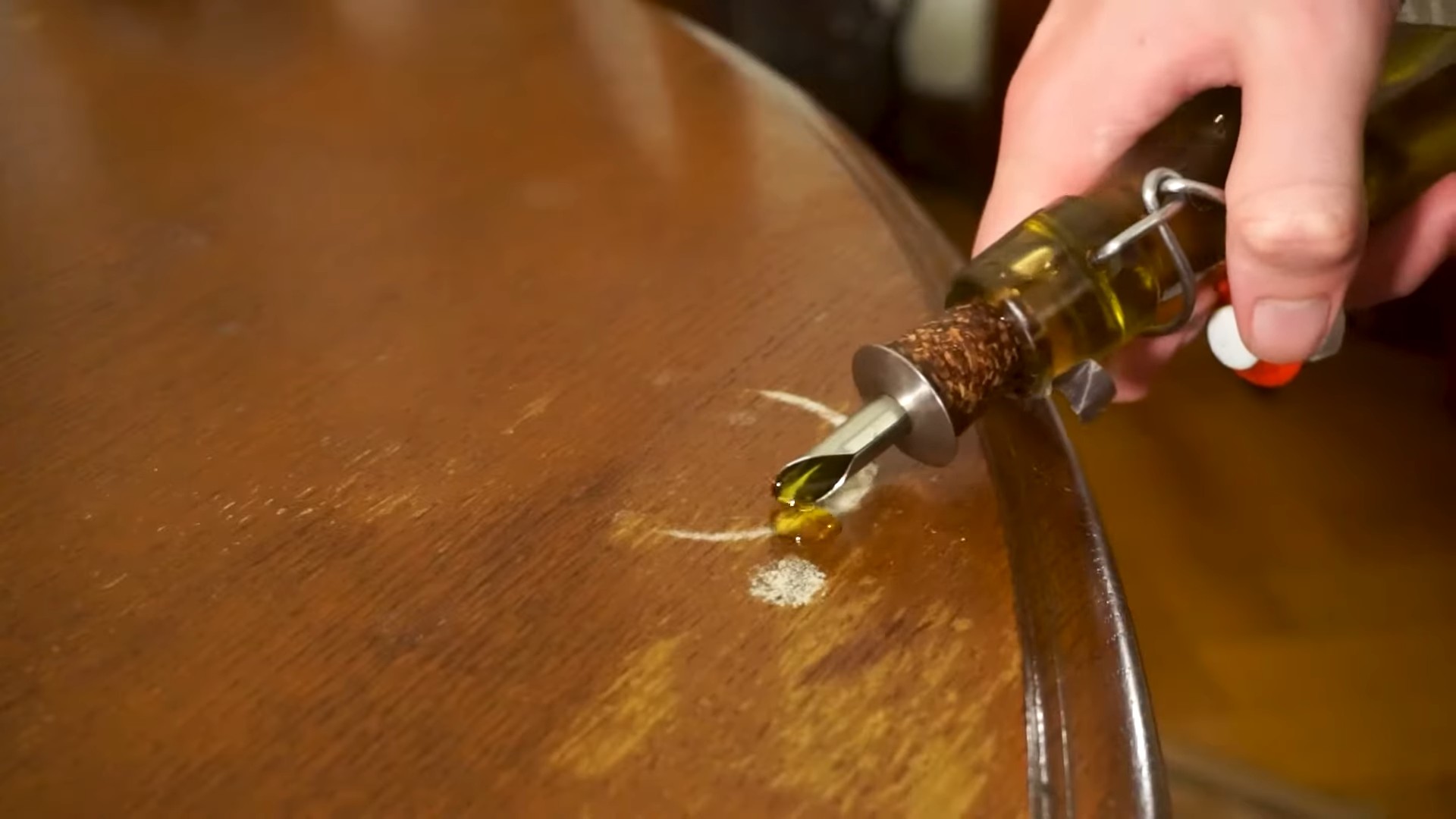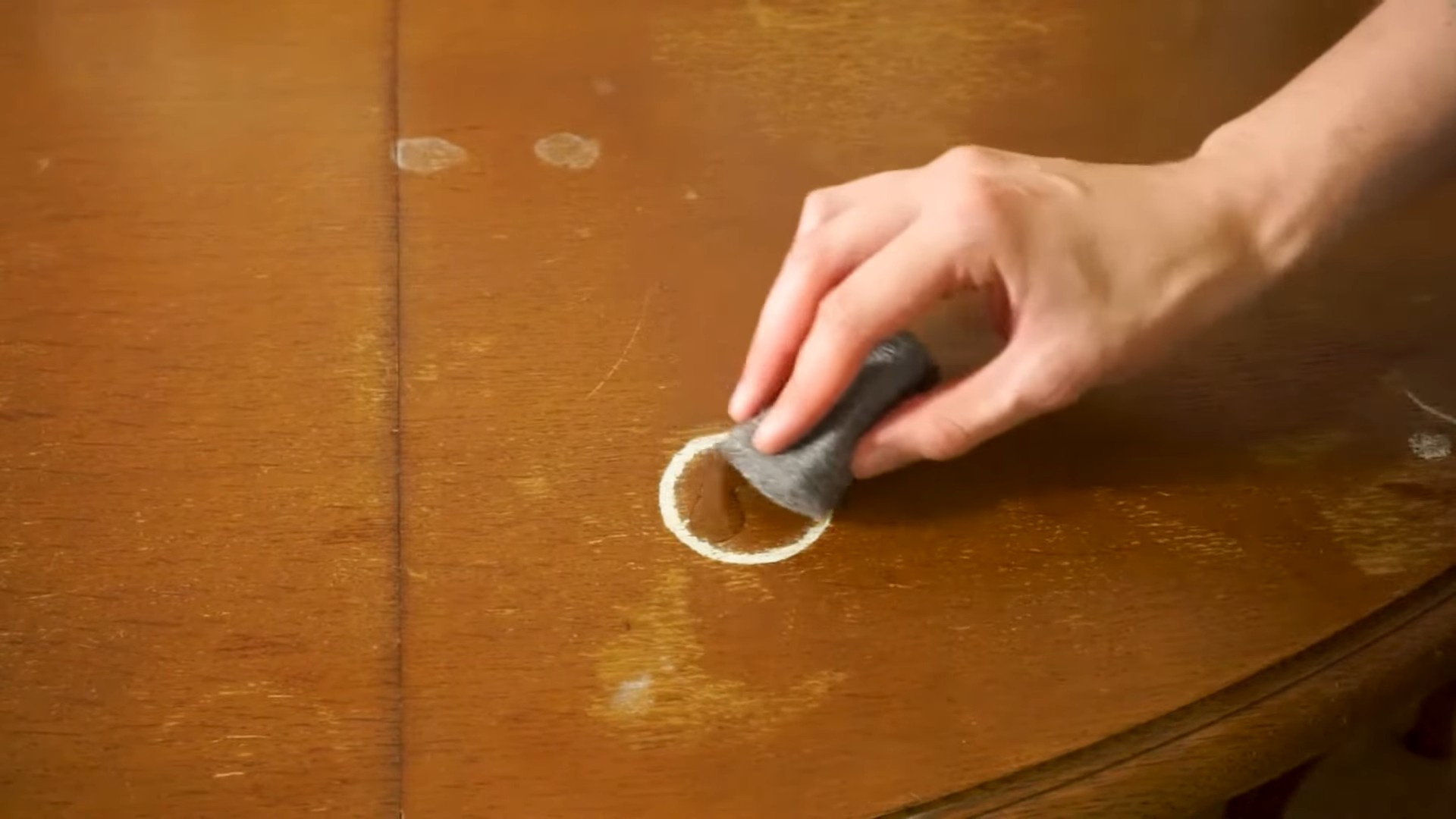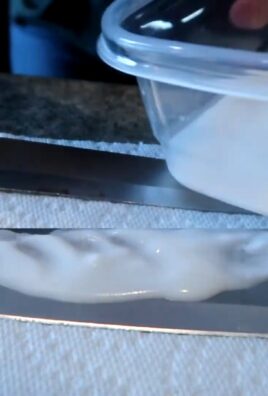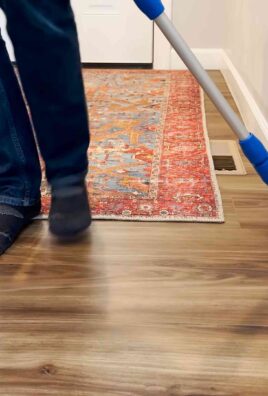Remove Water Rings Wood – those dreaded, ghostly circles that seem to appear on our beloved wooden furniture overnight! We’ve all been there, haven’t we? You set down a cool glass of iced tea, forget a coaster, and BAM! The next morning, a water ring stares back at you, mocking your momentary lapse in furniture protection. But don’t despair! This isn’t a furniture fatality; it’s merely a minor inconvenience that we can tackle together with some surprisingly simple DIY tricks.
For generations, preserving the beauty of wood has been a priority. From ancient Egyptians meticulously polishing their cedar chests to modern-day artisans crafting heirloom pieces, the care and maintenance of wood furniture has always been a sign of respect and appreciation. These water rings, however, are a relatively modern problem, arising with the increased use of varnishes and lacquers that, while protective, can trap moisture beneath the surface.
Why do you need these DIY hacks? Because replacing furniture is expensive and often unnecessary! Instead of resigning yourself to living with unsightly water rings or shelling out for professional refinishing, I’m going to share some easy, effective, and affordable methods to remove water rings wood and restore your furniture’s natural beauty. These tricks use common household items, saving you time, money, and the heartache of saying goodbye to a cherished piece. Let’s get started and banish those water rings for good!

DIY Water Ring Removal from Wood Furniture: A Comprehensive Guide
Hey there, fellow DIY enthusiasts! Water rings on wood furniture – the bane of our existence, right? I’ve battled them countless times, and I’m here to share my tried-and-true methods for banishing those pesky circles for good. Forget expensive furniture restorers; with a little elbow grease and some common household items, you can restore your wood furniture to its former glory. Let’s dive in!
Understanding the Enemy: What Causes Water Rings?
Before we jump into the solutions, it’s helpful to understand what we’re dealing with. Water rings are typically caused by moisture penetrating the finish of your wood furniture. This moisture can get trapped, creating a cloudy or white ring. The severity of the ring depends on the type of finish, the length of time the water sat, and the type of wood.
* Heat and Moisture: A combination of heat and moisture, like a hot mug of coffee, is the perfect storm for creating stubborn rings.
* Finish Type: Lacquer and varnish finishes are more susceptible to water rings than oil-based finishes.
* Wood Type: Some woods are more porous than others, making them more prone to absorbing moisture.
Method 1: The Hair Dryer Hack
This is my go-to method for fresh, light water rings. It’s gentle and often surprisingly effective.
What You’ll Need:
* Hair dryer
* Soft cloth (microfiber is ideal)
Step-by-Step Instructions:
1. Prepare the Area: Make sure the surface of the wood is clean and dry. Wipe away any excess moisture or debris with your soft cloth.
2. Heat Application: Set your hair dryer to a low or medium heat setting. Hold it a few inches away from the water ring.
3. Gentle Heating: Move the hair dryer back and forth over the ring in a sweeping motion. Don’t hold it in one spot for too long, as this could damage the finish.
4. Observe and Repeat: Keep an eye on the ring. You should start to see it fade as the heat evaporates the trapped moisture. This process can take anywhere from a few minutes to 15 minutes, depending on the severity of the ring.
5. Buff the Surface: Once the ring has disappeared, use your soft cloth to buff the area gently. This will help restore the shine and blend the treated area with the surrounding finish.
6. Repeat if Necessary: If the ring doesn’t completely disappear after the first attempt, repeat the process.
Method 2: The Iron and Cloth Trick
This method uses gentle heat and pressure to draw the moisture out of the wood. It’s a bit more aggressive than the hair dryer method, so proceed with caution.
What You’ll Need:
* Iron (dry, no steam)
* Thin cotton cloth (like a t-shirt)
* Water (optional, for stubborn rings)
Step-by-Step Instructions:
1. Prepare the Area: As with the hair dryer method, ensure the surface is clean and dry.
2. Cloth Placement: Place the thin cotton cloth directly over the water ring. Make sure the cloth is smooth and wrinkle-free.
3. Ironing Time: Set your iron to a low, dry setting (no steam!). Gently iron over the cloth in a circular motion. Don’t apply too much pressure.
4. Check Progress: Lift the cloth periodically to check the progress. You should see the ring starting to fade.
5. Repeat as Needed: Continue ironing in short bursts, checking frequently. If the ring is particularly stubborn, you can lightly dampen the cloth with water (wring it out thoroughly so it’s just barely damp) before ironing.
6. Buff and Polish: Once the ring is gone, remove the cloth and buff the area with a clean, soft cloth. You may want to apply a furniture polish to restore the shine.
Method 3: The Mayonnaise Miracle
Yes, you read that right! Mayonnaise contains oils that can help displace the trapped moisture and restore the finish. This is one of those weird tricks that actually works!
What You’ll Need:
* Mayonnaise (full-fat is best)
* Soft cloth
* Spoon or spatula
Step-by-Step Instructions:
1. Apply the Mayonnaise: Using a spoon or spatula, apply a generous dollop of mayonnaise directly onto the water ring.
2. Let it Sit: Allow the mayonnaise to sit on the ring for at least an hour, or even overnight for stubborn rings. The longer it sits, the better the chance it has to work its magic.
3. Wipe Away: After the allotted time, wipe away the mayonnaise with a clean, soft cloth.
4. Buff and Polish: Buff the area thoroughly with a clean cloth to remove any remaining residue. You may need to use a bit of elbow grease to get it all off. Finish with a furniture polish to restore the shine.
Method 4: The Toothpaste Technique
Non-gel toothpaste can act as a mild abrasive, helping to gently remove the water ring. Be very careful with this method, as it can potentially scratch the finish if you’re too aggressive.
What You’ll Need:
* Non-gel toothpaste (white, not colored or gel)
* Soft cloth
* Damp cloth
Step-by-Step Instructions:
1. Apply Toothpaste: Apply a small amount of toothpaste to a soft cloth.
2. Gentle Rubbing: Gently rub the toothpaste onto the water ring in a circular motion. Use very light pressure.
3. Wipe Away: After a minute or two, wipe away the toothpaste with a damp cloth.
4. Dry and Buff: Dry the area thoroughly with a clean, soft cloth and buff to restore the shine.
5. Inspect Carefully: Check the area carefully for any scratches. If you see any, use a furniture polish to help minimize their appearance.
Method 5: The Baking Soda Paste Power
Baking soda is another mild abrasive that can be effective for removing water rings. Like the toothpaste method, use caution to avoid scratching the finish.
What You’ll Need:
* Baking soda
* Water
* Soft cloth
Step-by-Step Instructions:
1. Make a Paste: Mix baking soda with a small amount of water to create a thick paste.
2. Apply the Paste: Apply the paste to the water ring using a soft cloth.
3. Gentle Rubbing: Gently rub the paste onto the ring in a circular motion. Use very light pressure.
4. Wipe Away: After a minute or two, wipe away the paste with a damp cloth.
5. Dry and Buff: Dry the area thoroughly with a clean, soft cloth and buff to restore the shine.
Method 6: The Steel Wool Savior (Use with Extreme Caution!)
This method is for *very* stubborn water rings and should only be used as a last resort. It involves using very fine steel wool to gently buff away the damaged finish. This can easily damage the finish if you’re not careful, so proceed with extreme caution and test in an inconspicuous area first.
What You’ll Need:
* 0000 steel wool (the finest grade available)
* Furniture polish or oil
Step-by-Step Instructions:
1. Test First: Before you start, test the steel wool in an inconspicuous area of the furniture to make sure it doesn’t scratch the finish.
2. Apply Polish: Apply a small amount of furniture polish or oil to the steel wool.
3. Gentle Buffing: Very gently buff the water ring with the steel wool, using a circular motion. Use extremely light pressure.
4. Wipe Away: Wipe away any residue with a clean, soft cloth.
5. Reapply Polish: Reapply furniture polish to the area to restore the shine and protect the finish.
Preventing Future Water Rings: A Proactive Approach
Prevention is always better than cure! Here are some tips to help you avoid future water ring disasters:
* Use Coasters: This is the most obvious and effective way to prevent water rings. Always use coasters under drinks, hot dishes, and anything that could potentially leave a mark.
* Use Placemats: Placemats can protect your dining table from spills and scratches.
* Wipe Up Spills Immediately: The longer a spill sits on your furniture, the more likely it is to cause damage. Wipe up spills immediately with a clean, dry cloth.
* Consider a Tablecloth: For special occasions, a tablecloth can provide an extra layer of protection.
* Regular Polishing: Regular polishing can help protect the

Conclusion
So, there you have it! Removing water rings from wood furniture doesn’t have to involve expensive products or professional help. This simple, DIY trick, using items you likely already have in your home, offers a surprisingly effective solution to those unsightly blemishes. We’ve walked you through the process, highlighting the importance of gentle application and patience. Remember, the key is to work with the wood, not against it.
Why is this DIY approach a must-try? Because it’s cost-effective, readily accessible, and minimizes the risk of further damage to your precious furniture. Commercial cleaners can sometimes contain harsh chemicals that strip the finish or discolor the wood. This method, on the other hand, relies on gentle heat and absorption, offering a safer and more controlled way to lift those stubborn water rings.
But don’t stop there! Experiment with variations to find what works best for your specific type of wood and finish. For instance, if you’re dealing with a particularly stubborn ring, try increasing the iron’s heat slightly (always starting on the lowest setting and testing in an inconspicuous area first). You could also try using a slightly damp cloth instead of a completely dry one, especially on older, more porous wood. Some people have found success using a hairdryer instead of an iron, providing a gentler, albeit slower, heat source. Another variation involves using a small amount of toothpaste (non-gel) as a mild abrasive before applying heat. Always test these variations on a hidden area first to ensure they don’t damage the finish.
Ultimately, the success of this DIY trick hinges on your careful execution and willingness to experiment. Don’t be discouraged if the first attempt doesn’t completely eliminate the ring. Sometimes, it takes a few tries, adjusting the heat and pressure as needed. The important thing is to be patient and persistent.
We are confident that this method will help you restore your wood furniture to its former glory. Say goodbye to those embarrassing water rings and hello to a beautifully maintained home. Now, it’s your turn! Give this DIY trick a try and share your experience with us in the comments below. We’d love to hear your success stories, any variations you’ve discovered, and any tips you have for fellow readers. Let’s build a community of DIY enthusiasts who are passionate about preserving the beauty of wood furniture. We encourage you to share before and after photos of your furniture transformation. Your insights could be invaluable to someone else struggling with the same problem. So, grab your iron, your cloth, and get ready to banish those water rings for good! This is the best way to remove water rings wood and keep your furniture looking its best.
FAQ
Frequently Asked Questions About Removing Water Rings from Wood
1. What causes water rings on wood furniture?
Water rings are caused by moisture becoming trapped beneath the finish of the wood. When a cold glass or damp object is placed on a wooden surface, the moisture condenses and penetrates the finish. This moisture then becomes trapped, creating a cloudy or white ring. The severity of the ring depends on the type of finish, the duration of exposure to moisture, and the type of wood.
2. What types of wood finishes are most susceptible to water rings?
Lacquered and varnished finishes are generally more susceptible to water rings than oil-based finishes. This is because lacquer and varnish create a harder, less breathable surface, making it easier for moisture to become trapped underneath. Oil-based finishes, on the other hand, tend to be more porous and allow moisture to evaporate more readily. However, all wood finishes are vulnerable to water rings if exposed to moisture for an extended period.
3. Can this DIY trick be used on all types of wood furniture?
This DIY trick is generally safe for most types of wood furniture, but it’s crucial to exercise caution and test it in an inconspicuous area first. Antique furniture or pieces with delicate finishes may require a more specialized approach. If you’re unsure about the type of finish on your furniture, consult a professional furniture restorer before attempting any DIY treatments.
4. What if the water ring is very old or dark?
Older or darker water rings may be more difficult to remove and may require multiple treatments. You may need to increase the heat of the iron slightly or apply gentle pressure while ironing. If the ring persists after several attempts, consider using a specialized wood cleaner or polish designed to remove water stains. As a last resort, you may need to refinish the affected area.
5. What kind of cloth should I use?
A clean, soft cotton cloth is ideal. Avoid using microfiber cloths, as they can sometimes be too abrasive and scratch the finish. An old t-shirt or pillowcase works well. Make sure the cloth is free of any dyes or prints that could transfer to the wood.
6. What temperature should I set the iron to?
Start with the lowest heat setting and gradually increase it as needed. It’s always better to start too low than too high, as excessive heat can damage the finish. Test the iron on an inconspicuous area first to ensure it doesn’t scorch or discolor the wood.
7. How long should I iron the water ring?
Iron the water ring in short bursts, checking the progress frequently. Avoid holding the iron in one spot for too long, as this can overheat the wood and damage the finish. Typically, 10-15 seconds at a time is sufficient.
8. What if the DIY trick doesn’t work?
If this DIY trick doesn’t work, there are other options you can try. You can try using a specialized wood cleaner or polish designed to remove water stains. Another option is to use a mixture of equal parts vinegar and olive oil. Apply the mixture to the water ring, let it sit for a few minutes, and then wipe it away with a clean cloth. If all else fails, you may need to consult a professional furniture restorer.
9. How can I prevent water rings from forming in the future?
The best way to prevent water rings is to use coasters or placemats under glasses, cups, and other items that could potentially leave moisture on the wood. You can also apply a protective coating of furniture polish or wax to help repel moisture. Be sure to wipe up any spills immediately to prevent them from soaking into the wood.
10. Can I use a hairdryer instead of an iron?
Yes, a hairdryer can be used as a gentler alternative to an iron. Set the hairdryer to a low heat setting and direct the airflow over the water ring. Move the hairdryer back and forth to avoid overheating the wood. This method may take longer than using an iron, but it’s a safer option for delicate finishes.
11. Is it safe to use toothpaste to remove water rings?
Non-gel toothpaste can be used as a mild abrasive to help remove water rings, but it’s important to use it sparingly and test it in an inconspicuous area first. Apply a small amount of toothpaste to the water ring, gently rub it in with a soft cloth, and then wipe it away with a clean, damp cloth. Be sure to remove all traces of toothpaste to prevent it from drying and leaving a residue.
12. How do I know if the finish is damaged?
Signs of finish damage include discoloration, cracking, peeling, or a dull appearance. If you notice any of these signs, stop using the DIY trick immediately and consult a professional furniture restorer.
13. Can I use this method on veneer furniture?
Use extreme caution when using this method on veneer furniture. Veneer is a thin layer of wood glued to a substrate, and it can be easily damaged by heat or moisture. Test the method in an inconspicuous area first, and use the lowest heat setting possible. If you’re unsure about the stability of the veneer, it’s best to consult a professional furniture restorer.
14. What if the water ring is on a painted surface?
This method is not recommended for painted surfaces. The heat from the iron can cause the paint to blister or peel. Instead, try gently wiping the water ring with a damp cloth and mild soap. If the ring persists, you may need to repaint the affected area.
15. Where can I find more information about wood furniture care?
There are many resources available online and in libraries about wood furniture care. You can also consult a professional furniture restorer for personalized advice. Remember, proper care and maintenance are essential for preserving the beauty and longevity of your wood furniture.





Leave a Comment